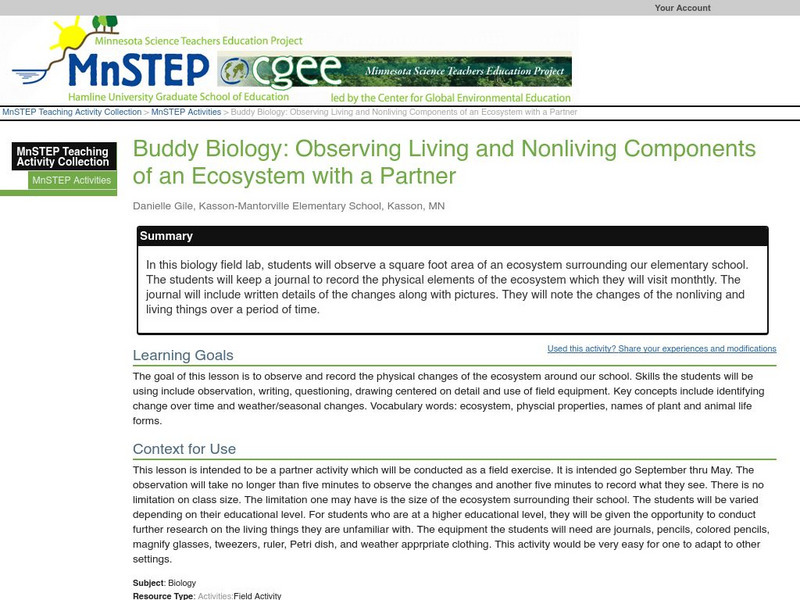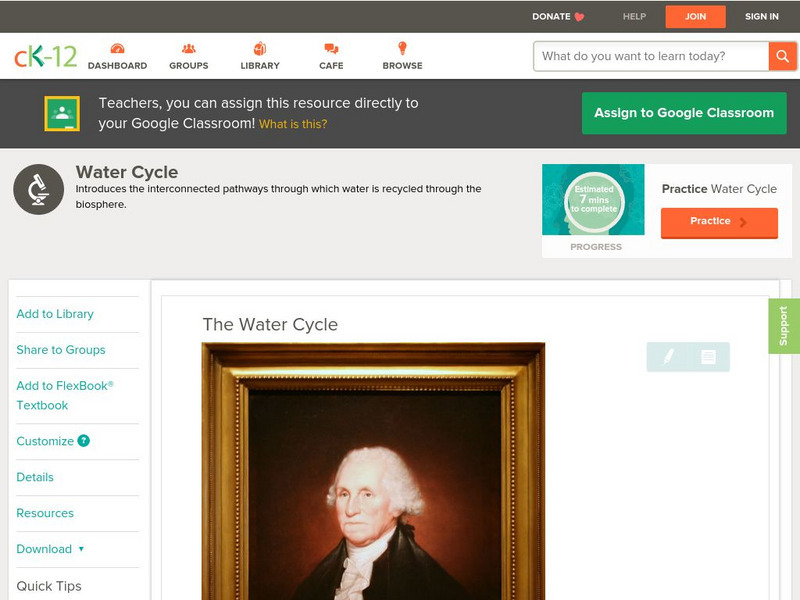Hi, what do you want to do?
Utah Education Network
Uen: Living and Nonliving
Third graders will be able to identify what is living and nonliving in the world around them.
Science Education Resource Center at Carleton College
Serc: Looking for Living and Nonliving Things
Students will think about what is alive and identify the objects they observe as living or nonliving. They will record their findings in a journal, share them with their classmates, then illustrate a page for a class book of things they...
Utah Education Network
Uen: Trb 3:2 Investigation 2 Greenhouses
Set up a miniature greenhouse to help with understanding how nonliving things affect the growth of living things.
Utah Education Network
Uen: Mini Ecosystems
Third graders will make small-scale environments and will describe interactions between living and nonliving things in their environments.
Utah Education Network
Uen: Looking at the Community Tree
A neighborhood tree is observed for evidence of interactions between living and nonliving things.
Utah Education Network
Uen: Trb 3:2 Investigation 3 Terrariums / Aquariums
Creating aquariums/terrariums help students understand how creatures depend on living and nonliving things.
E-learning for Kids
E Learning for Kids: Science: Marshall Islands: How Can We Tell Living Things From Non Living Things?
Andrea lives on the Marshall Islands, and she will teach you about living and nonliving things.
Utah Education Network
Uen: Are You Among the Living or the Nonliving?
Great site to test your knowledge on living and nonliving things. Play a game that tests your knowledge, and view pictures to pick out each living organism.
ArtsNow
Arts Now Learning: Dramatic Living and Non Living [Pdf]
Students explore the differences between living and nonliving things through the lens of the nursery rhyme, "Hey Diddle Diddle." After bringing the characters to life, the students discuss the concepts of living and nonliving and act out...
eSchool Today
E School Today: Your Revision Notes on the Characteristics of Living Things
Discusses the five characteristics that living things have and nonliving things do not.
Alabama Learning Exchange
Alex: Wanted Dead or Alive!
In this lesson plan students will identify the characteristics of living and nonliving things.
E-learning for Kids
E Learning for Kids: Science: Scotland: How Can We Group Living Things Based on Characteristics?
Lilly is from Peru, and she's traveling the world. Right now, she's in Scotland. Join her while she studies living and non-living things.
Utah Education Network
Uen: What It Is, What It Isn't
Recognize characteristics of living and nonliving items within an environment.
ClassFlow
Class Flow: Living and Nonliving
[Free Registration/Login Required] Flipchart details characteristics of living and nonliving things, then asks students to classify. Activote questions are included.
SMART Technologies
Smart: Living and Nonliving Things
Students define the characteristics of living and non-living things, identify living and non-living components of an ecosystem, and identify the roles of organisms in living systems.
Other
Vida: Living and Non Living Things
Study these four images when learning about living and nonliving things.
BiologyWise
Biology Wise: Comparison of Living and Non Living Things
Compares the characteristics of living and non-living things based on respiration, life processes, response to stimuli, death, and composition.
Science Education Resource Center at Carleton College
Serc: Observing Living and Nonliving Components of an Ecosystem With a Partner
In this biology field lab, students will observe a square foot area of an ecosystem surrounding our elementary school. The students will keep a journal to record the physical elements of the ecosystem which they will visit monthtly. The...
E-learning for Kids
E Learning for Kids: Science: Scotland: How Can We Group Non Living Things Based on Characteristics/purposes?
Montgomery is a true Scot, and even wears a kilt. He works in his dad's store and needs help learning about materials.
Utah Education Network
Uen: Are You Dead or Alive?
A great site that offers real life examples of what makes something living or nonliving.
Utah Education Network
Uen: What's Different About These Worms?
Observe three different worm models and identify characteristics.
Utah Education Network
Uen: Making a Mini Worm Habitat
Activity shows the process of converting organic waste into usable fertilizer.
Georgia Department of Education
Ga Virtual Learning: Ap Biology: Ecology
Students review the study of living things and make connections back to Earth's systems. This unit focuses on how various species, grouped in populations and communities, work with the nonliving things around them to ensure survival.
CK-12 Foundation
Ck 12: Life Science: Water Cycle
[Free Registration/Login may be required to access all resource tools.] Water and elements like carbon and nitrogen are constantly being recycled through the environment. This process is called a biogeochemical cycle because it involves...


















